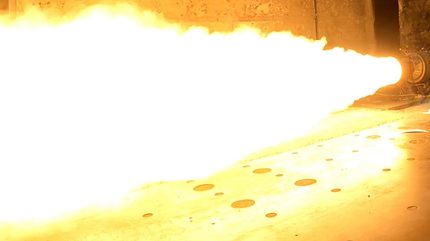
Two US defence primes – Raytheon, an RTX subsidiary, and Northrop Grumman – have successfully tested a new long-range Solid Rocket Motor (SRM), according to a statement issued on 12 September 2024.
In the form of a static fire test, the two companies verified the concept at the Northrup Grumman Allegany Ballistics Laboratory in West Virginia.
The test demonstrated wired end-burning technology for hypersonic applications and provided data to support digital modelling and simulations that validated the design maturity and performance of the SRM.
“This is a major milestone in proving the significant capability of this [SRM],” said Colin Whelan, president of Advanced Technology at Raytheon. “By leveraging industry collaboration, we were able to demonstrate that we can produce and meet requirements for challenging long-range fires kill chains.”
Hypersonic weapons
Raytheon and Northrop Grumman share a long history of collaborating on the development of hypersonic systems. Both are making investments in rocket motor testing to prove design stability and maturity that is necessary to deliver capability on an accelerated schedule.
Hypersonic refers to aerial objects—including aircraft, missiles, rockets, and spacecraft—that can reach speeds through the atmosphere greater than Mach 5, which is nearly 4,000 miles per hour (6437kmh). The Mach number indicates how many times the speed of sound an object is traveling

US Tariffs are shifting - will you react or anticipate?
Don’t let policy changes catch you off guard. Stay proactive with real-time data and expert analysis.
By GlobalDataThe US, Russia and China are all testing hypersonic technology, generating fears of escalating global competition for weaponry that has the potential to render current defences inadequate.
Although it can be said that there are deployable ‘hypersonic’ weapons today, it is debatable whether they are deployable in the strict sense of the word.
In Ukraine, for example, invading Russian forces have used their own ‘hypersonic’ missile: the Kinhzhal. There is a cruise missile and an air-launched ballistic missile. Both were used in the heaviest strike the invader has waged against Ukraine to date.
Ukraine needs long-range weapons
“This extremely important test of our wired end-burning technology provides extended range over conventional rocket motors,” said Frank DeMauro, vice president, Weapon Systems, Northrop Grumman.
Their joint collaboration on this technology comes at a time when the topic of long-range missiles continues to dominate, with Ukraine lobbying Western nations to approve its use of the weapons against Russian military installations deep inside Russia.

“If we are allowed to use this weaponry, we should be able to use it as needed, to strike military targets,” commented the President of Ukraine, Volodymyr Zelenskyy.
Yesterday (12 September) he emphasised that the unrestricted use of long-range capabilities would prove decisive.
“If restrictions are lifted on certain weapons but those weapons lack necessary missiles, then it’s not truly a lifting of restrictions. It’s another way of avoiding a positive decision on using specific weapons.”
With their hands tied, Ukraine’s forces resorted to an incursion inside Russia’s Kursk region to compensate for a deep strike capability.



